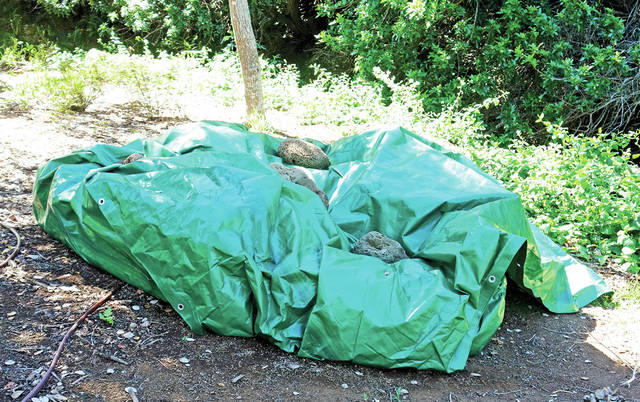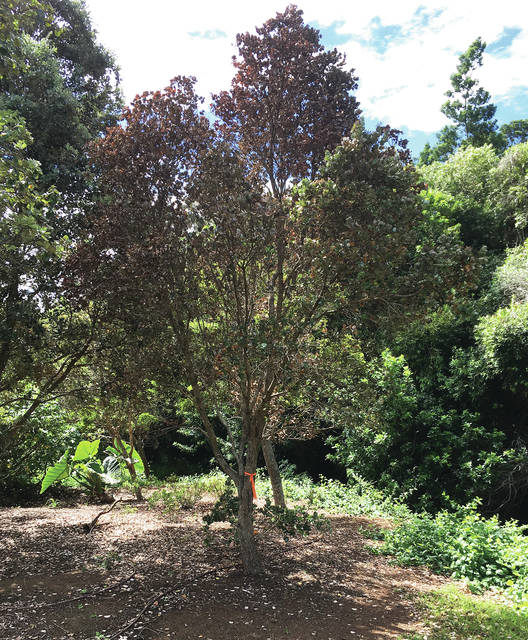WAIMEA — In late October, the first confirmed case of rapid ohia death (ROD) was reported in Ulu La’au, also known as Waimea Nature Park. A second case was reported last week.
J.B. Friday, an extension forester from the College of Tropical Agriculture and Human Resources (CTAHR) at University of Hawaii at Manoa, sent a crew from Big Island Invasive Species Committee (BIISC) to the park Nov. 5 to eradicate the infected ohia trees there.
“We’ve been really careful, putting up signs encouraging people not to pick any flowers off the ohia trees and were hoping ROD would stay out of Waimea,” Cheryl Langton said, Waimea Outdoor Circle’s board president. “We became suspicious about a month ago with two trees and had them tested because it’s the only way you know for sure.”
The two trees were on opposite sides of the park. BIISC cut them down.
“They cut them carefully with a handsaw. If you use a chainsaw or a power saw the sawdust can blow around carrying the disease. They wrapped the trees up in a tarp and stashed them in a corner where they’ll stay for six months before we were told we can dispose of them,” Langton said.
Two additional cases of ROD were confirmed recently near Burger King at Parker Ranch Center.
In the state of Hawaii, ROD cases have only been identified on the Big Island. Locations have included South Hilo, Puna, Ka’u, Kona, North Kohala, Hamakua and now Waimea.
Once the fungus infects a tree it can take a year or more for symptoms to become apparent. If suspected, samples can go through a testing process at CTAHR.
“We cut slices out of the tree and look for a black staining in the sapwood. If found, we take a sample back to the lab. There they try to grow the fungus and look for the fungus DNA,” Friday explained. “A chip of the wood is put on a slice of carrot, wrapped in plastic and allowed to grow for several days. If it’s there, black fungus will grow all over it.”
Several other samples on private land in Waimea are being tested currently.
“We generally see a lot less disease in cooler areas rather than in warmer ones, like Puna,” Friday said. “There’s very little disease so far in Waimea.”
Waimea Nature Park volunteers are attempting to prevent infection on additional ohia trees by using fertilizer and plenty of water.
“We’re also making sure no one is climbing the ohia trees. One time I came and someone had strung a hammock between two of them,” Langton said.
To help further educate the community on ROD, a special showing of the 30-minute documentary “Saving Ohia — Hawaii’s Sacred Tree” will be held at People’s Theater in Honokaa beginning at 6:45 p.m. this Thursday as part of the final Third Thursday Thrive event. A potluck and music will begin at 6 p.m.
The 30-minute documentary highlights the significance of Hawaii’s native tree. It provides an in-depth look into the cultural and ecological importance of the species and the potential impact of the current epidemic. Produced by CLUB SULLIVAN TV for the University of Hawaii Coordinating Group on Alien Pest Species, the documentary focuses on two new fungal pathogens causing rapid ohia death with suggestions from a team of scientists, conservationists and Hawaii residents on how to protect native forests and save ohia.
The origins of ROD
ROD is a newly discovered fungal disease caused by Ceratocystis fimbriata. The first cases on the Big Island were identified in 2014. BIISC is still learning about the disease from new cases.
CTAHR explains in an educational brochure that microscopic spores of the fungus enter ohia through a wound which can be caused by mowing over a tree’s roots, cutting through the bark with a weed whacker or pruning, strong winds that can break branches or damage from animals. Once the fungus enters the plant, it grows into the sapwood and blocks water movement.
The exact origin of the fungus is unknown.
ROD infected trees should be cut down by an arborist certified by the International Society of Arboriculture. BIISC has a list for Hawaii Island at www.biisc.org.
Residents who suspect trees affected by ROD can email photos, a timeline of the tree’s demise and the location of the tree to Friday at jbfriday@hawaii.edu. A short video explaining how to sample an infected tree can be seen at rapidohiadeath.org.





